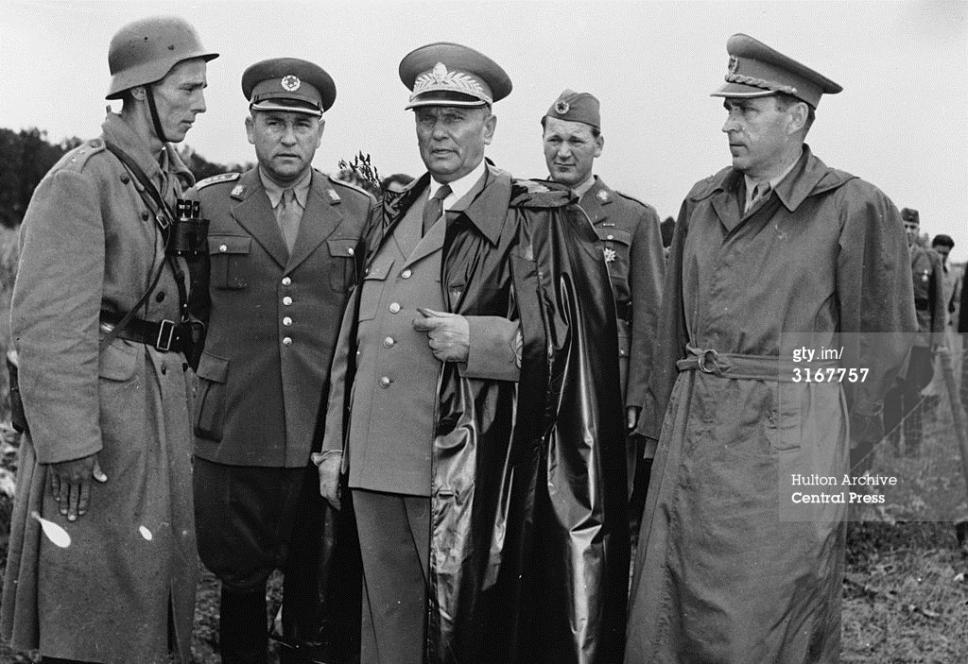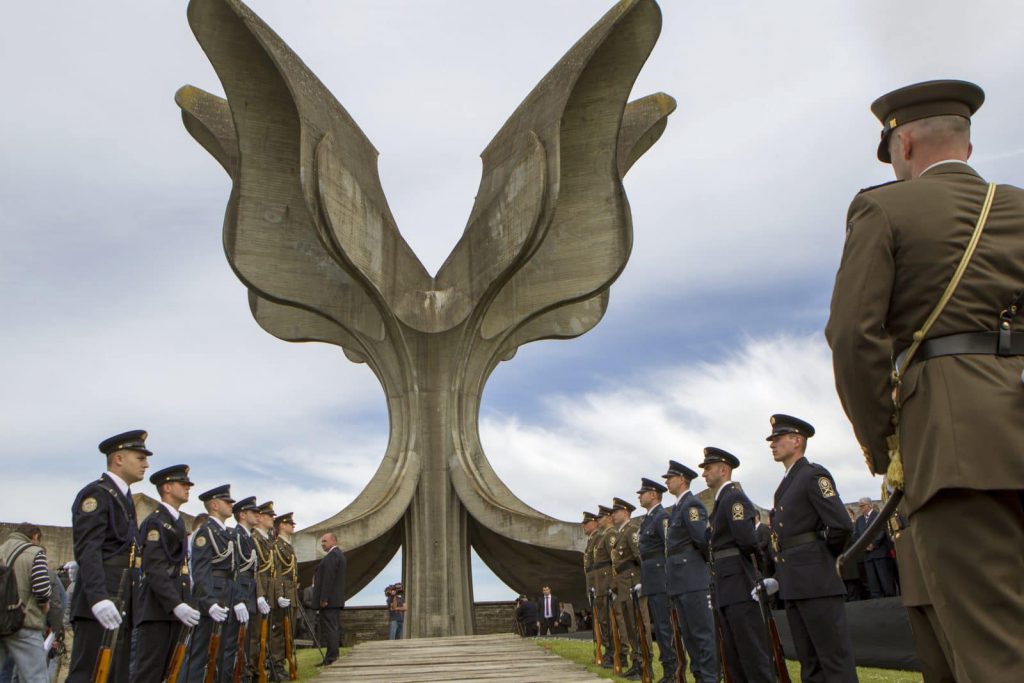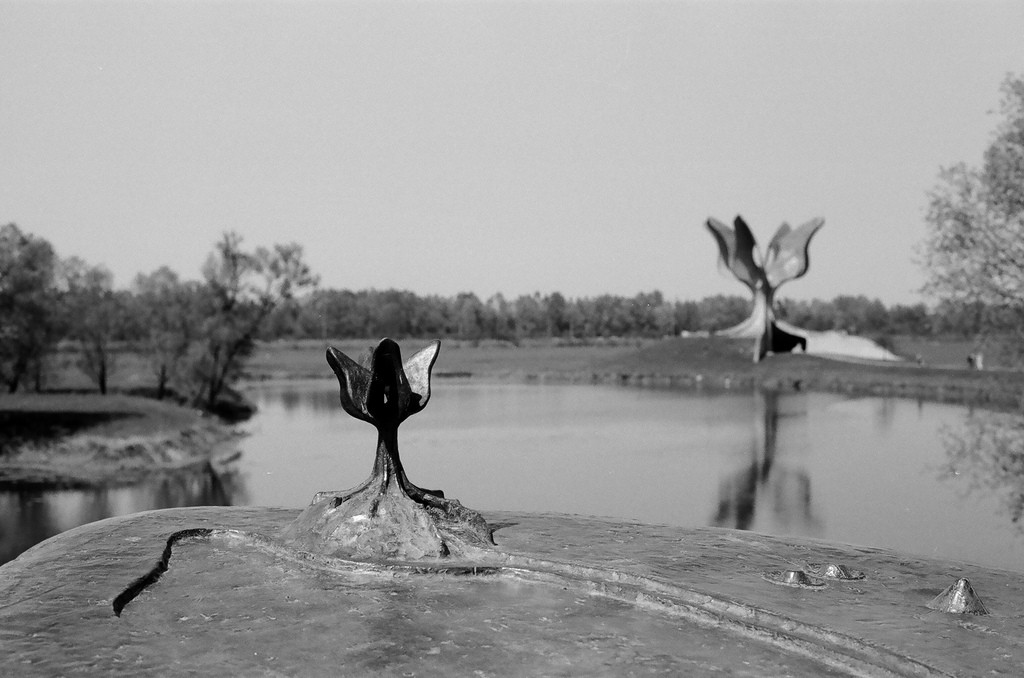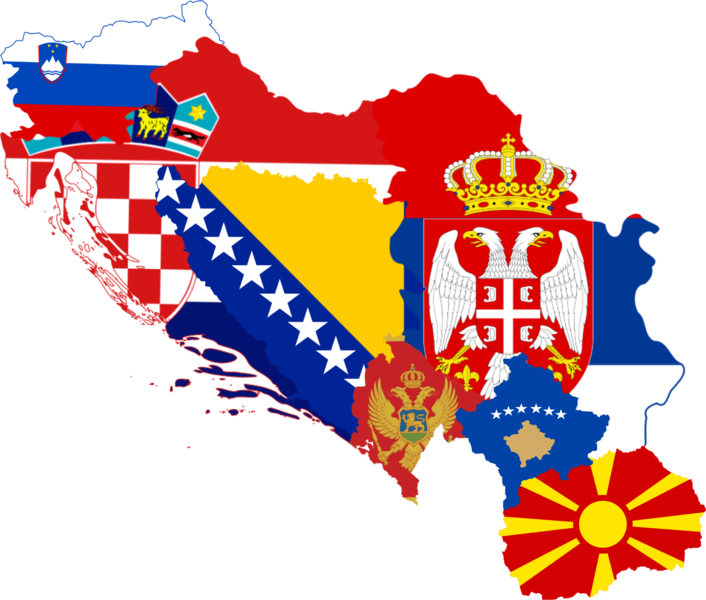
Views: 807

Tito’s policy in the 1970s of the so-called “encourage and suppress” for the sake to struggle against politically undesirable and threatening ethnic nationalisms especially the Croat and the Serb ones appeared to be incoherent one. In another words, while some ethnic nationalisms and their ideologies were considered to be dangerous to the system and, therefore, were suppressed and their advocates were jailed or banned from employment[i] (the case, for instance, of the Serbian dissident professors from Belgrade University), other nationalisms, supposed to be non-dangerous for the regime were encouraged by the local Communist elites (for instance, the Albanian nationalism in Kosovo-Metochia). Nevertheless, a Titoist attempt to suppress both Croat and Serb nationalisms and their political ideologies, as “reactionary” and “counter-revolutionary” doctrines, failed to eradicate them.[ii] In essence, such Titoist policy just relegated the Croat and the Serb nationalisms to the area of political dissidence and protest.
The dissident intellectuals who continued to criticize Titoist regime within the framework of the suppressed ethnic nationalisms and their national ideologies interpreted the Titoist policy of “encourage and suppress” as a systematic plot to humiliate their respective nations and to deny them their rightful share of power and influence at the expense of other, more favored nations. In practice, the Titoist encouragement of rival national ideologies served to fuel mistrust and, later in the 1990s, hate of those national and ethnic groups whose cultural and political emancipation was favored by Titoist Communist Government. Nevertheless, fueled by historical and new grievances, the old (19th-century) national ideologies did not remain within the framework of dissidence for some longer period of time as since the mid-1980s for the sake to widen their appeal and, therefore, secure their hold on power, the Titoist political leaders across the country, first in Serbia, and then in Slovenia and Croatia, expropriated the rhetoric of the dissident national ideologies and, subsequently, brought them into the fundamental political discourse. Practically, such national and political ideologies became very fitting instruments for the channeling of the popular grievances among the masses who accepted the discourses about the others as foreign oppressors of their own national or ethnic groups.[iii]
Surely, ethnic rivalries continued to poison Yugoslavia throughout the whole postwar time until its final destruction. From the mid-1980s, in all ex-Yugoslav republics, political leaders used nationalistic rhetoric to erode a common Yugoslav identity and fuel fear and mistrust among different ethnic groups. By 1991, the break-up of the country loomed with Slovenia and Croatia who were unjustifiably blaming Serbia of dominating Yugoslavia’s Government, military and finances. Serbia, in turn, accused these two northern republics of unconstitutional separatism. However, in Bosnia-Herzegovina, the conflict was to be the deadliest of all in the disintegrating Yugoslav Federation as this republic was most mixed from both ethnic and confessional viewpoints. Bosnia-Herzegovina was as well as the only Yugoslav republic without a clear absolute majority of any ethnic or confessional group. This central Yugoslav republic had a shared government reflecting very mixed ethnic composition with the population made up of about 44 per cent Bosnian Muslims, 32 per cent Bosnian Serbs, 17 per cent Bosnian Croats followed by other nationalities (the 1991 census).[iv] The republic’s geostrategic position and its ethnic composition made it be subject to both Serbian and Croatian nationalism attempting to assert dominance over large parts of its territory. As a matter of illustration, the leaders of Croatia (Franjo Tuđman) and Serbia (Slobodan Milošević) met on April 16th, 1991 in a secret meeting in Karađorđevo[v] (Vojvodina province in Serbia) where they in principle agreed to divide up Bosnia−Herzegovina between Serbia and Croatia, leaving a small enclave for the Bosniaks.[vi]
The first precise step to begin the necessary general changes in Yugoslavia after Tito’s death in regard with national questions in order to reform the country for the sake to survive was done by the Serbian intellectuals and academicians in 1985 when on May 23rd Assembly of the Serbian Academy of Sciences and Arts (the SANU) decided to draw up a scientific study of current social issues and problems in Yugoslavia. The product of this work became known as the Memorandum of the SANU (published in 1986 in the newspapers by a secret police) which was calling for the general improvement of the position of the oppressed Serb nation in Yugoslavia[vii] but especially in Croatia and Kosovo-Metochia where the Serbs were terrorized, expelled and killed without a proper reaction by the Federal Yugoslav Government. The Memorandum, in fact, presented a cruel reality of a Titoist solution of the national questions as the Serbs were continually under threat and economically exploited and, therefore, the signatories of this document called for re-centralization of the country or revision of its internal borders. However, this Memorandum was labeled by the ruling Communist authority as a clear expression of Serb nationalism.
That a Serb Question in Yugoslavia was really acute problem became clear on April 24th, 1987 when a group of Kosovo-Metochia’s Serbs met Serbia’s party’s leader Slobodan Milošević in Priština’s suburb of Kosovo Polje when they required protection against the Albanian systematic terror as the Albanians constantly were creating political tensions in the province. During the meeting, Kosovo’s Albanian police forces were brutally beating the Serb civilians. The Albanian terrorism against Yugoslavia was exported outside Kosovo-Metochia on September 3rd of the same year when in the YPA’s barracks at Paraćin in Serbia, an Albanian conscript from Kosovo-Metochia (Keljmendi) killed four fellow soldiers and wounds five in the sleeping room during the night. From that moment, the Albanian terrorism became a focal security problem to be resolved for the Government of Serbia which did not get any support by other Yugoslav republics in this matter. In fact, Slovenia and Croatia even openly supported Kosovo’s Albanian terrorism and secessionism.[viii]
Common national support to the idea of protecting the Serb nation across Yugoslavia came on June 28th, 1989 on the 600th year anniversary of the Battle of Kosovo at Gazimestan near Priština attended by circa one million Serbs from all parts of Yugoslavia. On this historical occasion, from June 1988 till June 1989 reliquary of the Serbian Prince Lazar, canonized participant in the 1389 battle against the Ottomans, was on its journey from Serbia’s Orthodox monastery of Ravanica across Serb populated parts of Yugoslavia for the sake of returning to the genuine Serb religious and national roots. The spirit of a Serbian unity was expressed on July 9th 1988 when started several mass arrival of Kosovo-Metochia’s oppressed Serbs in Vojvodina’s administrative centre of Novi Sad followed by a series of meetings in Vojvodina, which finally resulted in the fall of the secessionist and anti-Serbian provincial Government under the pressure by the will of people. It was the first direct step toward re-unification of Serbia that was, the abolition of political separatist autonomy of the two provinces within it but as well as for political unification of all Yugoslav Serbs. For the Serbs, it was quite clear that only by achieving the desired political and national unification could the Serbs in Yugoslavia be really liberated from “the rule of non-Serbs in Yugoslavia”[ix] and be equal with other Yugoslav nations and republics within the same federation.
 The people of Montenegro expressed their Serb national feelings and a wish to live together with Serbia and other Yugoslav Serbs on January 10th, 1989 when in a series of people’s meetings, culminating in Podgorica (former Titograd) attended by some 50,000 people, changed Montenegro’s anti-Serbian and pro-Croatian/Slovenian Government.
The people of Montenegro expressed their Serb national feelings and a wish to live together with Serbia and other Yugoslav Serbs on January 10th, 1989 when in a series of people’s meetings, culminating in Podgorica (former Titograd) attended by some 50,000 people, changed Montenegro’s anti-Serbian and pro-Croatian/Slovenian Government.
However, regardless of the very fact that the form which the Serb political-national unification is going to be was left quite undefined (a single Federal unit?), such political attitude surely triggered and served as a model for similar projects and political campaigns in all other Yugoslav republics but primarily in neighboring Croatia. From the summer of 1989, Slovenia and Croatia formed a united anti-Serbian front as for them the prospect of any kind of Serb unification was a policy of Serb domination over other national groups in Yugoslavia but, in fact, Ljubljana and Zagreb wanted to preserve their post-1945 domination over the rest of the Yugoslav federation. In another word, the Slovenian and the Croatian leading Communist authorities launched their own political campaigns for the “liberation” of their respective nations from Yugoslavia (secessionism) as any unprivileged position in Yugoslavia for Slovenia and Croatia was not acceptable. As a consequence, in January 1990 the Croatian Communist leadership joined their counterpart from Slovenia in withdrawing from the last Yugoslav Communist party’s (the League of Communist of Yugoslavia) Congress (the 14th Extraordinary Congress) held in Belgrade (January 20th‒22nd) and, therefore, quite effectively destroying the only political movement which supported an idea of the Yugoslav unification.
Nevertheless, the Slovenian and the Croatian Communist leaderships’ enthusiasm for re-newed patriotism of their own republics and nationalism of their own nations could not match the new nationalist political parties established in 1989 by the former nationalist dissidents like, for instance, Dr. Franjo Tudjman. As a result, at the elections in April-May next year the new nationalist and ultranationalist parties took power in Slovenia and Croatia from the former Communists regardless of the fact that Slovenia’s and Croatia’s Communist parties previously became reformed and even re-named.
The parliamentary and presidential elections in Slovenia were held on 7th and 8th April 1990. The new Government was formed by a coalition of five non-Communist parties (the DEMOS-Democratic Opposition of Slovenia), with 50,9 per cent of getting votes and 55,1 per cent of having seats in the Parliament. A leader of reformed and re-named Slovenian Communists, Milan Kučan (born in Serbia in 1941), became elected President of the Republic of Slovenia.[x]
In Croatia, a newly formed ultranationalist party of the Croatian Democratic Union (the HDZ, established on June 17th, 1989) under the leadership of Dr. Franjo Tudjman (previously sentenced for several years in jail for the nationalistic activities in the 1970s) started to gain very fast popular support mainly due to its anti-Serbian rhetoric and glorification of a Nazi-fascist Ustashi regime during WWII. However, for Croatia’s Serbs it became obvious that the time of WWII Ustashi committed genocide over them is knocking on Croatia’s door and, therefore, they decided to self-organize themselves in order to struggle against re-born Nazifascist ideology and movement in Croatia. One of the first mass rallies of the Serbs in Croatia against the Nazification of the country by the HDZ was organized in Petrova Gora on March 4th, 1990 during the electoral campaign for the Parliament (Sabor) of Croatia when it was already clear who was going to win the elections.
The first round of elections in Croatia was held in April 22nd and 23rd, 1990 followed by the second round on May 6th and 7th with a clear HDZ’s victory, with 41,5 per cents of votes and 68,8 per cent of seats in the Parliament. A transfer of authority in Croatia occurred on May 30th, 1990 when a new multiparty Parliament elected Franjo Tudjman as a President of Croatia.
Franjo Tudjman (1922‒1999), born in Zagorje region in Croatia like Tito, was during the first several months of WWII fighting in the Ustashi uniform when changed the side to Tito’s Partisans under the invitation of his father. After the war, Tudjman became a General and was working in the Yugoslav Defense Ministry and on the General Staff of the YPA till 1961 when he was appointed as a director of the Institute for the History of the Workers’ Movement in Croatia. In 1967 he lost the position due to his linguistic nationalism and was twice imprisoned for his nationalistic anti-Serbian activities. He and his HDZ in the 1990s were espousing a Croatian ultranationalistic platform, having been supported by Western democracies, especially by Germany, have remained in power and have played a very important role in the process of the destruction of Yugoslavia.[xi] Tudjman, who earned in Titoslavia a Ph.D. in history, is the author of numerous books[xii] (from an academic viewpoint they are very problematic and contested, especially the book: Wilderness of Historical Reality, Zagreb, 1989).
As a President of Croatia, Tudjman used the presidency post for nation-building, ethnic cleansing of Croatia’s Serbs from Krayina region in August 1995, leading to major controversy and to “crimes against humanity in the war in Bosnia-Herzegovina”.[xiii] Tudjman was the main sponsor of a new “Christmas” Constitution of the Republic of Croatia adopted on December 22nd, 1990 according to which, the Serbs in Croatia lost its constitutive position and became a simple ethnic minority with very limited minority rights.[xiv]
In Bosnia-Herzegovina, on May 26th, 1990 a Party of Democratic Action (the SDA) was founded in Sarajevo with Alija Izetbegović (c. 1925‒2000) as the President. The party was a political organization of Bosnian-Herzegovinian Muslims (Bosniaks) with the final political aim to transform this republic into an Islamic state according to the example of Iran. Alija Izetbegović himself was in jail for the first time in the late 1940s for three years because of his advocacy in the favor of Islamic fundamentalism while in the 1970s he was persecuted for the writing and signing fundamentalist Islamic Declaration. During WWII he was a member of an infamous SS Hanjar Division created by Heinrich Himmler composed by the Bosnian-Herzegovinian Muslim fundamentalists. Izetbegović was born in Bosanski Šamac, like Dr. Zoran Djindjić, in a Muslim family of a Slav origin. After WWII, he became a lawyer writing various works on Yugoslav’s Muslims. Izetbegović was jailed for the second time in 1983‒1988 after publishing his book Islam Between East and West (1982)[xv] for the spreading an ideology of Islamic religious nationalism. He became a leader of the Muslim-oriented SDA which won a simple parliamentary majority (29,6 per cent) at the elections in Bosnia-Herzegovina (November and December 1990) becoming a President of the Presidency of Bosnia-Herzegovina on December 20th, 1990.
After Slovenia’s and Croatia’s secession from the rest of Yugoslavia on June 25th, 1991, Izetbegović proclaimed the republic’s independence on March 3rd, 1992 breaking a previous common political deal between the three leading national political parties in Bosnia-Herzegovina. However, his Government soon found itself at war with the Bosnian-Herzegovinian Serbs who did not support an independent state dominated by the Muslim-Croat (the Roman Catholic) coalition. The Croats, nevertheless, soon found themselves at war with Izetbegović’s fundamentalistic Islamic Government. During the war, Izetbegović was traveling around the Muslim world and other countries in order to gain financial, diplomatic and military support for his idea to transform Bosnia-Herzegovina into the Islamic State and to fight against the Serbs.
In Serbia, the final legal unification of her state’s territory happened on July 5th, 1990 when a People’s Assembly of Serbia in Belgrade, based on previous Kosovo’s provincial Assembly’s decision, annulled both the Government and the Assembly of Kosovo-Metochia and assumed their political prerogatives. From that day onward, Serbia as a republic was legally equal with the rest of the other five republics of the SFRY. However, Kosovo’s Albanian nationalistic members of dismissed provincial Assembly met in secret in Kačanik in South Kosovo-Metochia on September 7th and adopted illegal Constitution of the independent Republic of Kosovo which nobody recognized in the world. Three days later, on September 10th, the Slovenian and the Croatian Governments officially proposed a political platform of re-constructed Yugoslav federation according to the model of the confederal state of the asymmetric union in which they will enjoy privileged economic and financial position with a very weak confederal Government. The proposal was immediately rejected by both Serbia and Montenegro as ridiculous and unfair. However, any further serious talks upon the future of Yugoslavia was impossible after October 8th‒10th, 1990 when Croatia imported 20,000 machine guns from neighboring Hungary and when this operation was discovered and recorded by the YPA’s military intelligence service (the KOS).
The multi-party elections in Serbia and Montenegro were held on December 8th and 9th, 1990 in which pro-Milošević’s supporters won at a great extent as the reaction to the electoral results in Croatia in April-May of the same year. Slobodan Milošević (1941‒2006), being himself of the Montenegrin origin, became elected President of Serbia.[xvi] He studied law at Belgrade University and held various offices in both the Communist party and in the municipal administration of Belgrade. Milošević became head of the Serbian League of Communists in 1987 and then head of Serbia’s Government. His popularity among the Serbs was founded on his policy of re-unification of post-WWII dismembered Serbia and his political success to re-integrate Vojvodina and Kosovo-Metochia into Serbia before the elections. He drew great attention to and played on the real fears and ambitions of Serbs living outside Serbia without Kosovo-Metochia[xvii] helping at the same time foment popular demands for the unification of the Serbs within Yugoslavia or her remains.[xviii]
www.global-politics.eu/sotirovic
sotirovic@global-politics.eu
© Vladislav B. Sotirović 2019
Endnotes:
[i] Such policy of political persecution was nothing new in Titoslavia as it was just the continuation of the practice from the first decade after October 1944. About the Titoist methods of creating an atmosphere of power and fear, see in [Алекс Н. Драгнић, Титова обећана земља Југославија, Београд: Задужбина Студеница−Чигоја штампа, 2004, 141−158].
[ii] About the ideology of Serbian nationalism, see in [Др Војислав Шешељ, Идеологија српског национализма. Научно и публицистичко дело проф. др Лазе М. Костића, Београд: Српска радикална странка, 2003]. The author of this publication (Vojislav Šešelj) is a Croat from Bosnia-Herzegovina. On the 19th-century Serbian patriotic ideas, see in [Проф. Др Драган Симеуновић, Из ризнице отаџбинских идеја: Слободарски међаши наше политичке мисли 19. века, Београд: Војска−Верзал Прес, 2000]. About a Croat nationalism and nationalistic ideologies before 1945, see in [Jere Jareb, Pola stoljeća hrvatske politike, 1895−1945, Zagreb: Institut za suvremenu povijest, 1995]. The author was the Ustashi emigrant living in Argentina after WWII. The book was originally published in Buenos Aires in 1960.
[iii] Aleksandar Pavković, “National Liberations in Former Yugoslavia: When Will They End?”, East European Quarterly, XXXVI, № 2, 2002, 239.
[iv] On the national composition of Bosnia-Herzegovina by districts, see in [Susan L. Woodward, Balkan Tragedy: Chaos and Dissolution after the Cold War, Washington, D. C.: The Brooking Institution, 1995, 226−227].
[v] Вељко Ђурић Машина (уредник), Република Српска Крајина десет година послије, Београд: Добра воља, 2005, 22.
[vi] About the history of Bosnia-Herzegovina from the Western perspective, see in [Robert J. Donia, John V.A. Fine, Jr., Bosnia and Hercegovina: A Tradition Betrayed, New York: Columbia University Press, 1994].
[vii] Gregory C. Ference (ed.), Chronology of 20th-century East European History, Detroit‒Washington, D. C.‒London: Gale Research Inc., 420.
[viii] About the issue of terrorism in Yugoslavia from a historical perspective, see in [Др Радослав Ђ. Гаћиновић, Насиље у Југославији, Београд: ЕВРО, 2002].
[ix] Aleksandar Pavković, “National Liberations in Former Yugoslavia: When Will They End?”, East European Quarterly, XXXVI, № 2, 2002, 239.
[x] Branka Magaš, Ivo Žanić (eds.), The War in Croatia and Bosnia-Herzegovina 1991‒1995, London‒Portland, OR: Frank Cass, 2001, 349.
[xi] Vladislav B. Sotirović, „Breaking Cliché on the Killing of Yugoslavia: A Role of Croatia“, Зборник о Србима у Хрватској (Review of the Serbs in Croatia), Vol. 11, Serbian Academy of Sciences and Art, Belgrade, Serbia, 2017, ISSN 0353-5967, 129−150.
[xii] Richard Frucht (ed.), Encyclopedia of Eastern Europe from the Congress of Vienna to the Fall of Communism, New York‒London: Garland Publishing, Inc., 2000, 812. About Tudjman, from the official Croatian perspective, see more in [Davor Butković, Dubravko Grakalić, Prilozi za političku biografiju Dr. Franje Tudjmana Predsjednika Republike Hrvatske, Zagreb, 1991].
[xiii] José M. Magone, Contemporary European Politics: A Comparative Introduction, London‒New York: Routledge Taylor & Francis Group, 2011, 174.
[xiv] About Tudjman’s Croatia, see in [Jill A. Irvine, “Ultranationalist Ideology and State-Building in Croatia, 1990−1996”, Problems of Post-Communism, Vol. 44, № 4, July-August 1997, 30−43; Sabrina P. Ramet, “Politics in Croatia since 1989”, Sabrina P. Ramet (ed.), Central and Southeast European Politics since 1989, Cambridge: Cambridge University Press, 2010].
[xv] Alija Ali Izetbegovic, Islam Between East and West, Indianapolis, 1989.
[xvi] On Serbia’s electoral politics in 1990, see in [Robert Thomas, The Politics of Serbia in the 1990s, New York: Columbia University Press, 1999, 69−79].
[xvii] That the Serb fears were real clearly proved the case of Serb Djordje Martinović from Kosovo-Metochia who was in May 1985 impaled on a broken bottle by two Albanians. However, the Yugoslav authorities launched the explanation that he impaled himself on a bottle which then broke. That was, in fact, the best example of the Albanian nationalistic terror against the Serbs which clearly illustrated the real fears the Kosovo-Metochia’s Serbs have [Gregory C. Ference (ed.), Chronology of 20th-century East European History, Detroit‒Washington, D. C.‒London: Gale Research Inc., 420]. About uncompleted chronicle of the Albanian terror over Kosovo-Metochia’s Serbs from 1941 to 1989, see in [Радован Самарџић и други, Косово и Метохија у српској историји, Београд: СКЗ, 405−436]. About historical Golgotha of Kosovo-Metochia’s Serbs, see in [Јеврем Дамњановић, „Косовска Голгота“, Intervju, специјално издање, 22-10-1988, Београд].
[xviii] See more in [Слободан Милошевић, Године расплета, Београд, 1989; Aleksa Djilas, “A Profile of Slobodan Milošević”, Foreign Affairs, 72, 1993, 81‒96].

Origins of images: Facebook, Twitter, Wikimedia, Wikipedia, Flickr, Google, Imageinjection & Pinterest.
Read our Disclaimer/Legal Statement!
Donate to Support Us
We would like to ask you to consider a small donation to help our team keep working. We accept no advertising and rely only on you, our readers, to keep us digging the truth on history, global politics, and international relations.








